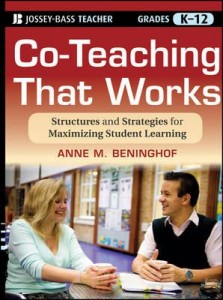Co-Teaching: Ideals & Realities
Co-Teaching That Works: Structures and Strategies for Maximizing Student Learning
by Anne M. Beninghof
(Jossey-Bass, 2012 – Learn more)
Having started my teaching career as a special education inclusion teacher, then spending many years as a regular ed teacher, often with inclusion classes, and now, being a special education inclusion teacher again, I was anxious to read this book. I hoped to gain insights to structure my new school year more efficiently and effectively to meet the varied needs of my students.
I came away from the book with mixed feelings. There were many ideas and practical suggestions I took away. Other parts left me frustrated that I could not see the ideas ever working in my own situation.
Beninghof, a former special educator and well known trainer, does a fantastic job of describing the wide spectrum of possible scenarios of co-teaching, from the typical special ed teacher teamed with a regular education teacher (and the possible ways to juggle those roles), to best utilizing a paraeducator, technology specialist or ELL specialist in your classroom. For each role, Beninghof offers concrete, workable solutions to sharing responsibilities and roles within the classroom.

In my setting, special education teachers are spread thinly across the population, working with a broad spectrum of regular ed teachers, students, subjects and grade levels. I would love to be able to work in the Duet partnership setting, but realistically, I don’t see it being a possibility. I love the ideas given – step by step, who does what, how it works, how it looks, and checklists of responsibilities. Utopia. The best.
The other models become more doable for my situation –The Lead & Support Model where the special educator is more of a supportive role in the classroom, involved in some of the planning, or the Speak and Add Model, where the special educator supports the regular education teacher but is less involved. Other models might be applicable, depending on the two teachers in the partnership.
The challenge of shared planning
The biggest frustration for me was the emphasis on shared planning. I know this is critical for success; I just don’t know how to carve it out of the day. For me, my prep is during an academic hour for students, because I have them for a Guided Study support hour during their elective time when regular ed teachers have their prep. This means that all the planning time with a regular education teacher must be ‘found.’ Not too tough if you team teach with just one teacher; nearly impossible when you team with 5 different teachers.
The book is a valuable resource for co-teachers in any role of the partnership. Not only does it offer advice on how to structure your partnership, it offers advice on settling conflicts, prioritizing roles and responsibilities, and concrete ways to adapt assessments and lessons/instruction.
The appendix is full of creative ideas/activities for adapting lessons for all learners. One that I especially liked was “Character Layers.” When studying character traits in language arts, give each student six sheets/strips of clear laminate. Students are assigned a character and write one trait of that character on each strip, creating an overlay effect where each layer builds on the previous ones. When completed, students take turns at the overhead, introducing one trait at a time, giving the class a chance to try and guess the character. This activity is visual and easily differentiated, and students would love the interactive part. The appendix has many of these types of activities which can be adapted for various ages and content areas.
Overall, I would give the book a solid B+. If Beninghof could send a magic wand along with it to help create common planning time, I would boost her grade to a A-! All that said, this book is well worth having as a key resource in your professional library.
Cossondra George is a middle/high school special education and math teacher. She enjoys writing about her teaching experiences and has had several articles featured in Education Week’s Teacher including Teaching Students How to Learn. George engages students using technology and has been active in helping other teachers integrate technology into their classrooms. She also blogs about her teaching days at Middle School, Day by Day from a Teacher’s Point of View.




































